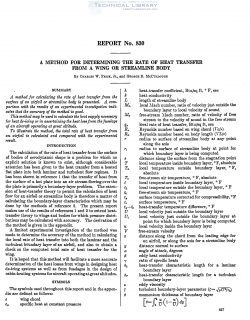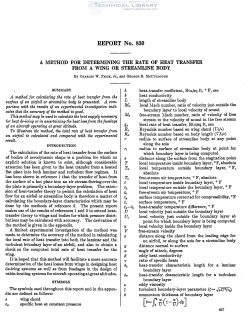naca-report-830

- Version
- 160 Downloads
- 951.53 KB File Size
- 1 File Count
- August 31, 2016 Create Date
- August 31, 2016 Last Updated
National Advisory Committee for Aeronautics, Report - A Method for Determining the Rate of Heat Transfer from a Wing or Streamline Body

A method for calculating the rate of heat transfer from the
surface of an aidoil or streamline body is presented. A com-
parison with the results of an experimental inrestigation indi-
cates that the accuracy of the method is good.
Thismethod- may be used to calculate the heat supply necessary
for heat tie-icing or in ascertaining the heat lossfrom the fuselage
of an aircrafl operating at great altitude.
To illustrate the method, the total rate of heat transfer from
an airfoil is calculated and compared un'th the experimental
result.
The calculation of the rate of heat transfer from the surface
of bodies of aerodynamic shape is a problem for which no
explicit solution is known to exist, although considerable
attention has been given to the heat transfer from a heated
flat plate into both laminar and turbulent flow regimes. It
has been shown in reference 1 that the transfer of heat from
the surface of a hot plate into an air stream flowing over the
the plate is primarily a boundary-layer problem. The exten--
sion of heat-transfer theory to permit the calculation of heat
flow for an airfoil or streamline body is therefore a matter of
calculating the boundary-layer characteristics which may be
done by the methods of reference 2. The present report
makes use of the results of references 1 and 2 to extend heat-
transfer theory to wings and bodies for which pressure distri-
butions may be calculated with accuracy. The derivation of
the method is given in the appendix.
A limited experimental investigation of the method was
made to determine the accuracy of the method in calculating
the local rate of heat transfer into both the laminar and the
turbulent boundary layer of an airfoil, and also to obtain a
check on the computed total rate of heat transfer for the
wmg.
It is hoped that this method will facilitate a more accurate
determination of the heat losses from wings in designing heat
de—icing systems as well as from fuselages in the design of
cabin-heating systems for aircraft operating at great altitudes.
| File | Action |
|---|---|
| naca-report-830 A Method for Determining the Rate of Heat Transfer from a Wing or Streamline Body.pdf | Download |

Comment On This Post